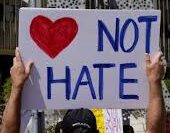
The Los Angeles County Report on Hate Crimes was presented to the Culver City Equity and Human Relations Commission at the Sept. 26, 2023 meeting at the Culver City Senior Center. Marshall Wong, who gave the presentation to the meeting, works with the Network Against Hate Crime, a county wide entity that provides training for law enforcement and service providers. His take on the information was candid, and challenging.
“The bad news is, of course, that it’s bad, and it’s getting worse.” While hate crimes in LA County saw a sharp increase during the early years of previous federal Republican administration, they have not decreased significantly since then. Looking at official data from 2021, the picture was daunting.
Hate crimes in LA County increased 23% in 2021, the biggest increase since 2002. 74% of hate crimes were violent in nature, and racial hate crimes were up 17%.
Wong noted “The people who are most frequently the target of hate crimes – African Americans, LGBT, members of the Jewish community, and Asian Americans – are consistently at the top of the list for hate crimes everywhere in the county.” Although they only comprise about 9% of the county’s population, African Americans were disproportionately targeted and comprised 46% of racial hate crime victims. Religious crimes spiked 29% and the rate of violence was the highest on record. 74% of these attacks targeted Jews.
Wong also reflected that the majority of hate crimes are not reported, and law enforcement projects that the actual numbers could be up to twenty times higher.
“Factors that may inhibit victims from reporting hate crimes include fear of retaliation, cultural and linguistic isolation, unfamiliarity with the criminal justice system, and previous negative experiences with law enforcement. For LGBT hate crime victims who are not “out” to their families, employers or neighbors there may also be fear of unwanted publicity that would disclose their sexual orientations or gender identities.”
Focusing in on the basic information of what is classified as a hate crime, and what that means in regard to response and prosecution, gave those in the audience a better understanding.
From the report,”Hate crime charges may be filed when there is evidence that bias, hatred, or prejudice based on the victim’s real or perceived race/ethnicity, religion, ancestry, national origin, disability, gender, or sexual orientation is a substantial factor in the commission of the offense. This definition is codified in the California penal code sections 422.55 to 422.95 pertaining to hate crime. Evidence of such bias, hatred, or prejudice can be direct or circumstantial. It can occur before, during, or after the commission of the offense.
“Hate speech is a criminal offense when the perpetrator has threatened violence with spoken or written words against a specific person or group of persons. The threat must be immediate, unconditional, and unequivocal. It must also cause the victim sustained fear. Frequently, derogatory words or epithets are directed against a member of a protected class, but no violence is threatened. Such hate incidents are important indicators of intergroup tensions. They are not, however, criminal offenses. Such language is protected by free speech rights set forth in the California and U.S. constitutions.”
In the state of California, graffiti is a hate crime when it takes the form of vandalism that is disparaging to a class of people protected by hate crime laws. This is most often indicated by the use of epithets or hate group symbols or slogans. To be a hate crime, graffiti must be directed at a specific target. For example, racial graffiti on a freeway overpass that does not address itself to a particular person is vandalism, and therefore illegal, but probably not considered a hate crime. Vandalism of a house of worship or of an ethnic, religious, or gay and lesbian organization may be investigated as a hate crime in the absence of evidence of other motives.
While overall crime is down, it’s important to consider the number of hate crimes in the context of overall crime statistics. The Los Angeles County Sheriff’s Department documented a 1% decrease in violent crime and a 12% decrease in property crime in 2021. Within that same time frame, hate crimes grew across all categories, with the largest increase in racial crimes, which jumped 17% from 406 to 473.
Calling 211 – the number to contact with social services – is also the number to call and report a hate crime. While some hateful attacks may not reach the level of criminal accountability, it is helpful to let authorities know.
Judith Martin-Straw

